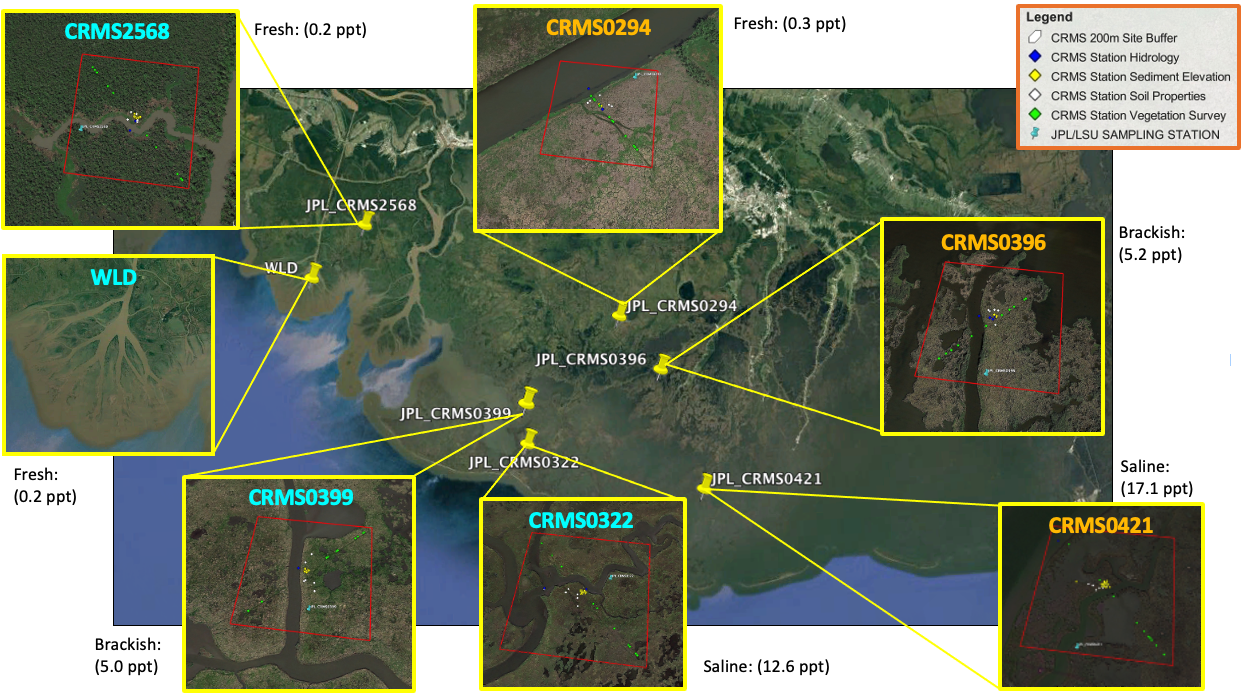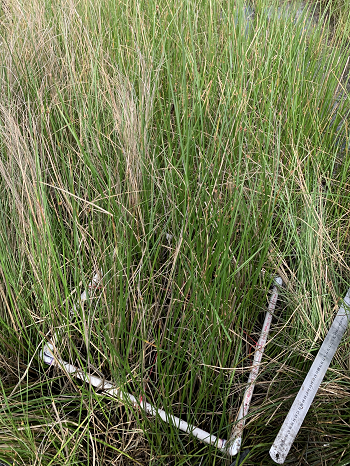Documentation Revision Date: 2023-09-15
Dataset Version: 1
Summary
There is one data file in comma separated values (.csv) format with this dataset.
Citation
Castañeda-Moya, E., and E. Solohin. 2023. Delta-X: Foliar Stable Isotopes, MRD, LA, USA, 2021. ORNL DAAC, Oak Ridge, Tennessee, USA. https://doi.org/10.3334/ORNLDAAC/2194
Table of Contents
- Dataset Overview
- Data Characteristics
- Application and Derivation
- Quality Assessment
- Data Acquisition, Materials, and Methods
- Data Access
- References
Dataset Overview
This dataset contains foliar tissue C and N bulk isotopic signatures (delta 13C, delta 15N) of dominant wetland herbaceous species collected at six sites in the Atchafalaya (N = 3) and Terrebonne (N = 3) basins in coastal Louisiana. Five of the sites are from the Coastwide Reference Monitoring System (CRMS) and one site is the Mike Island Site in the Wax Lake Delta (WLD). For the herbaceous wetland sites, Aboveground biomass (AGB) was harvested inside duplicate plots (0.25 m2), located 5 m apart at each sampling station. All plant material within each plot was clipped at soil level, stored in plastic bags, and transported to the laboratory for further analyses. In the lab, plant tissue (foliar) C and N bulk isotopic signatures were analyzed for two dominant plant species from each site using a Thermo Scientific Delta V Plus CF-IRMS coupled to a Carlo-Erba 1108 elemental analyzer via a ConFlo IV interface (Thermo Fisher Scientific, Waltham, MA, USA). The data were collected during 2021-08-19 to 2021-08-27 during the Delta-X Fall 2021 deployment.
The Delta-X Fall 2021 field deployment was conducted across the Atchafalaya and Terrebonne basins to assess changes in aboveground vegetation with seasonality along salinity and soil nutrient gradients.The field sampling period of August 19-27, 2021 corresponds to the period of peak biomass and a period of low river discharge.
Project: Delta-X
The Delta-X mission is a 5-year NASA Earth Venture Suborbital-3 mission to study the Mississippi River Delta in the United States, which is growing and sinking in different areas. River deltas and their wetlands are drowning as a result of sea level rise and reduced sediment inputs. The Delta-X mission will determine which parts will survive and continue to grow, and which parts will be lost. Delta-X begins with airborne and in situ data acquisition and carries through data analysis, model integration, and validation to predict the extent and spatial patterns of future deltaic land loss or gain.
Related datasets
Castañeda-Moya, E., and E. Solohin. 2022. Delta-X: Aboveground Biomass and Necromass across Wetlands, MRD, Louisiana, 2021. ORNL DAAC, Oak Ridge, Tennessee, USA. https://doi.org/10.3334/ORNLDAAC/2000
Castañeda-Moya, E., and E. Solohin. 2023. Delta-X: Root Stable Isotopes from Herbaceous Wetlands, MRD, LA, USA, August 2021. ORNL DAAC, Oak Ridge, Tennessee, USA. https://doi.org/10.3334/ORNLDAAC/2193
Castaneda, E., A.I. Christensen, M. Simard, A. Bevington, R. Twilley, and A. Mccall. 2020. Pre-Delta-X: Vegetation Species, Structure, Aboveground Biomass, MRD, LA, USA, 2015. ORNL DAAC, Oak Ridge, Tennessee, USA. https://doi.org/10.3334/ORNLDAAC/1805
Related Publications
Thomas, N., M. Simard, E. Castañeda-Moya, K. Byrd, L. Windham-Myers, A. Bevington, and R.R. Twilley. 2019. High-resolution mapping of biomass and distribution of marsh and forested wetlands in southeastern coastal Louisiana. International Journal of Applied Earth Observation and Geoinformation 80:257–267. https://doi.org/10.1016/j.jag.2019.03.013
Acknowledgement
This study was funded by the NASA Science Mission Directorate’s Earth Science Division through the Earth Venture Suborbital-3 Program NNH17ZDA001N-EVS3.
Data Characteristics
Spatial Coverage: Atchafalaya and Terrebonne Basins and the Wax Lake Delta (WLD), Louisiana, U.S.
Spatial Resolution: Points. Samples were collected from plots (0.25 m2) located 5 m apart.
Temporal Coverage: 2021-08-19 to 2021-08-27
Temporal Resolution: One-time estimate
Study Area: Latitude and longitude are given in decimal degrees.
| Site | Westernmost Longitude | Easternmost Longitude | Northernmost Latitude | Southernmost Latitude |
|---|---|---|---|---|
| Atchafalaya and Terrebonne Basins | -91.8852 | -90.8219 | 29.5106 | 29.1714 |
Data file information
There is one data file in comma separated values (.csv) format with this dataset: DeltaX_Foliar_Stable_Isotopes_Fall2021.csv
There are no missing values in the file.
Table 1. Variables in the data file.
| Variable | Units | Description |
|---|---|---|
| basin | - | “Atchafalaya” or “Terrebonne” |
| campaign | - | Fall_2021 |
| date | YYYY-MM-DD | Date of sample collection |
| latitude | degrees north | Latitude of sampling site in decimal degrees |
| longitude | degrees east | Longitude of sampling site in decimal degrees |
| site | - | Site name-five sites are from the Coastwide Reference Monitoring System (noted as "CRMS0### in the data file) and one site is the Mike Island Site in the Wax Lake Delta (noted as "WLD" in the data file)-refer to Fig 2 in Section 5 of this doc |
| hydrogeomorphic_zone | - | "Intertidal" |
| sampling_station | - | Sampling station identifier |
| species | - | Vegetation identified by species |
| 15N | ‰ (per mille) | δ15N, 15N isotopic signature, or isotope 15N concentration in ppt (‰, per mille) as relative to the international standards and atmospheric air |
| 13C | ‰ (per mille) | δ13C, 13C isotopic signature, or isotope 13C concentration in ppt (‰, per mille) as relative to the international standards and atmospheric air |
Application and Derivation
Foliar isotopic signatures estimates will be used to assess how plant intra-nutrient cycling efficiency changes in response to different environmental conditions.
Quality Assessment
Replicate samples of foliar plant material from two dominant species at each site were used to compute an average. Foliar C and N bulk isotopic signatures (δ13C, δ15N) analyses were performed using duplicate analytical replicates of each sample and the run precision was determined based on the relative percent difference between replicates at an acceptance limit of <5%. Accuracy was determined by the analysis of certified standard reference material during each run. Acceptable limits for accuracy were ±5 %. Data outside these limits were not used.
Data Acquisition, Materials, and Methods
Aboveground biomass (AGB) was collected at six sites in the Atchafalaya (N = 3) and Terrebonne (N = 3) basins in coastal Louisiana. Five out of the six selected sites for field measurements are part of the Coastal Reference Monitoring System (“CRMS”; Steyer et al., 2003). One site is at the Mike Island site in the Wax Lake Delta (WLD) (Figure 2). Samples were collected during August 19 – 27, 2021; this time corresponds to the period of peak biomass and a period of low river discharge. The Fall 2021 field deployment was conducted to assess changes in aboveground vegetation with seasonality along salinity and soil nutrient gradients.

Figure 2. Study area locations in the Atchafalaya and Terrebonne basins in coastal Louisiana. (there are no samples from site CRMS2568).
At each herbaceous wetland site, duplicate sampling stations (30 m apart) were established parallel to the wetland edge at 25 and 50 m within the intertidal zone to capture within site variability in vegetation dynamics and soil properties. In WLD (Mike Island Site), due to a variety of elevation ranges within the wetland site, duplicate stations were established in the high and intermediate intertidal zones. For the herbaceous wetland sites, AGB was harvested inside duplicate plots (0.25 m2), located 5 m apart at each sampling station. All plant material within each plot was clipped at soil level, stored in plastic bags, and transported to the laboratory for further analyses.
In the lab, the plant material collected at all plots was sorted by species using standard field protocols, oven-dried at 60ºC to a constant mass, and weighed using a standard laboratory semi-analytical balance (0.01 g precision) (Thomas et al., 2019). Subsamples of aboveground material were ground with a Wiley Mill to pass through a 40-µm-mesh screen and stored separately in glass scintillation vials. Plant tissue (foliar) C and N bulk isotopic signatures (δ13C, δ15N) were analyzed for two dominant plant species at each site using a Thermo Scientific Delta V Plus CF-IRMS coupled to a Carlo-Erba 1108 elemental analyzer via a ConFlo IV interface (Thermo Fisher Scientific, Waltham, MA, USA). Stable isotope data are reported in δ13C (‰) and δ15N (‰) notation as relative to the international standards and atmospheric air (Sulzman, 2007).
Data Access
These data are available through the Oak Ridge National Laboratory (ORNL) Distributed Active Archive Center (DAAC).
Delta-X: Foliar Stable Isotopes, MRD, LA, USA, 2021
Contact for Data Center Access Information:
- E-mail: uso@daac.ornl.gov
- Telephone: +1 (865) 241-3952
References
Castañeda-Moya, E., and E. Solohin. 2022. Delta-X: Aboveground Biomass and Necromass across Wetlands, MRD, Louisiana, 2021. ORNL DAAC, Oak Ridge, Tennessee, USA. https://doi.org/10.3334/ORNLDAAC/2000
Castañeda-Moya, E., and E. Solohin. 2023. Delta-X: Root Stable Isotopes from Herbaceous Wetlands, MRD, LA, USA, August 2021. ORNL DAAC, Oak Ridge, Tennessee, USA. https://doi.org/10.3334/ORNLDAAC/2193
Castaneda, E., A.I. Christensen, M. Simard, A. Bevington, R. Twilley, and A. Mccall. 2020. Pre-Delta-X: Vegetation Species, Structure, Aboveground Biomass, MRD, LA, USA, 2015. ORNL DAAC, Oak Ridge, Tennessee, USA. https://doi.org/10.3334/ORNLDAAC/1805
Steyer, G.D., C.E. Sasser, J.M. Visser, E.M. Swenson, J.A. Nyman, and R.C. Raynie. 2003. A proposed coast-wide reference monitoring system for evaluating wetland restoration trajectories in Louisiana. Coastal Monitoring through Partnerships. Environmental Monitoring and Assessment 81:107-117. https://doi.org/10.1023/A:1021368722681
Sulzman, E.W. 2007. Stable isotope chemistry and measurement: a primer. In R. Michener and K. Lajtha (eds). Stable Isotopes in Ecology and Environmental Science. Blackwell Publishing; Wiley Online Library. https://doi.org/10.1002/9780470691854.ch1
Thomas, N., M. Simard, E. Castañeda-Moya, K. Byrd, L. Windham-Myers, A. Bevington, and R.R. Twilley. 2019. High-resolution mapping of biomass and distribution of marsh and forested wetlands in southeastern coastal Louisiana. International Journal of Applied Earth Observation and Geoinformation 80:257–267. https://doi.org/10.1016/j.jag.2019.03.013
